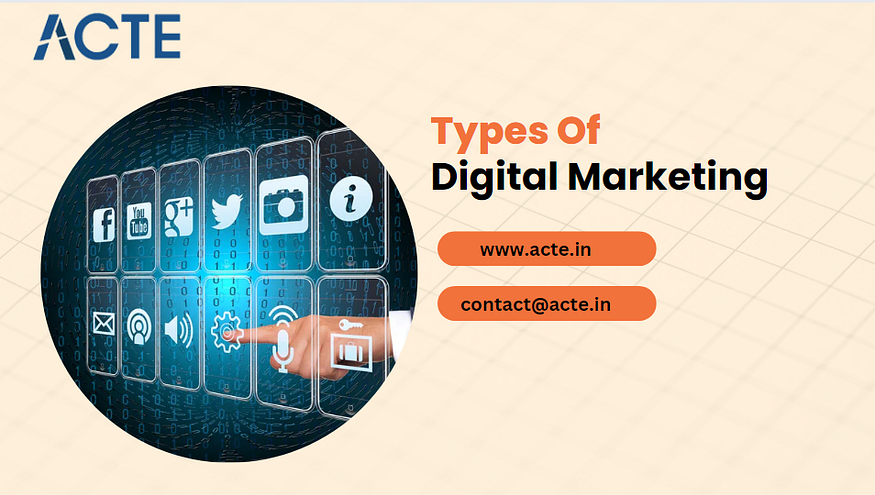Navigating the Digital Marketing Landscape: A Multifaceted Approach
Digital marketing was an irrelevant perception to consumers and marketers two decades ago. But as the number of users of the internet is increasing rapidly day by day.Let’s quickly run through the different types of Digital Marketing platforms and media that can be used in business.
Digital marketing comes in a variety of forms. Learn the different types of digital marketing and how they work together to form a comprehensive marketing strategy.

In the fast-paced world of digital marketing, the ever-evolving digital landscape offers a multitude of avenues for businesses to connect with their audiences. Each type of digital marketing serves distinct purposes and caters to different consumer behaviors. Let’s explore the diverse ecosystem of digital marketing strategies that businesses employ to thrive in the online realm.
Here Are Some of The Most Common Types of Digital Marketing:
1.Search Engine Optimization (SEO): This foundational strategy focuses on optimizing your online content to improve your website’s visibility in search engine results. It’s the key to attracting organic, non-paid traffic.
2. Content Marketing: Content is king. This strategy revolves around creating valuable and relevant content, such as blog posts, articles, videos, and infographics, to engage and educate your audience.
3. Social Media Marketing: Social media platforms like Facebook, Twitter, Instagram, and LinkedIn are vibrant hubs for connecting with your audience, promoting products or services, and building brand awareness.
4. Email Marketing: The trusty email remains a potent tool for building relationships with customers, sharing updates, and driving sales through personalized communication.
5. Pay-Per-Click (PPC): PPC advertising involves running paid ads on search engines or social media platforms, with businesses paying a fee each time someone clicks on their ad.
6. Affiliate Marketing: Businesses collaborate with affiliates who promote their products or services in exchange for a commission on sales generated through their efforts.

7. Influencer Marketing: Leverage the popularity and credibility of social media influencers to promote your products or services to their followers.
8. Video Marketing: Video content on platforms like YouTube and social media is a dynamic way to convey information, engage audiences, and connect on a personal level.
9. Social Media Advertising: In addition to organic social media posts, businesses can run paid advertising campaigns on these platforms to reach specific target audiences.
10. Mobile Marketing: As mobile device usage continues to surge, it’s essential to optimize content and ads for mobile platforms and apps.
11. Content Syndication: Republish your content on third-party websites to extend your reach and connect with new audiences.
12. Display Advertising: Visual display ads, including banner ads and interstitial ads, are a common sight on websites, apps, and social media.
13. Remarketing (Retargeting): This strategy targets users who have previously visited your website but didn’t take the desired action, displaying ads as they explore other online spaces.
14. Chat Marketing: Chatbots and messaging apps are harnessed to interact with customers, providing information and assistance with a personal touch.
15. Local SEO and Marketing: These strategies focus on increasing your business’s visibility in local search results, using platforms like Google My Business to attract local customers.
16. Marketing Automation: Streamline and automate marketing tasks, such as email campaigns and lead nurturing, to increase efficiency and effectiveness.
17. Voice Search Optimization: As voice-activated devices rise in popularity, optimizing content for voice search becomes crucial.
18. E-commerce Marketing: Tailored for online businesses, this strategy includes product listings, shopping ads, and engagement on online marketplaces.
19. Podcast Marketing: Capitalize on the growing podcast medium by advertising within podcasts or creating your own to reach niche audiences.
20. Growth Hacking: This experimental approach involves testing various strategies to rapidly grow your audience and customer base.
Each of these digital marketing strategies plays a unique role in helping businesses establish their online presence, engage with audiences, and drive growth. The right mix of strategies depends on your business goals, target audience, and available resources.
Many successful businesses employ a combination of these methods to create a comprehensive and effective digital marketing plan that adapts to the evolving digital landscape.
Save hundreds of hours by learning from working professionals with the best digital marketing course in Hyderabad. Right team for your training needs.
Don’t waste time thinking, it’s time to act. Contact ACTE Technologies for more details.

Comments
Post a Comment